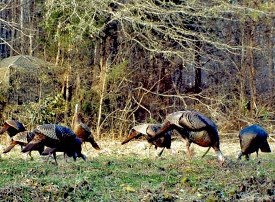John Phillips | March 01, 2010
 Many times subordinate gobblers won’t gobble in the place where the boss gobbler resides. But when the subordinate gobbler hears a lonesome hen feeding away from the flock, he may come in silently, hoping to breed a hen that the boss gobbler hasn't reached yet. This tactic resembles the strategy used when you call in a satellite bull when elk hunting. The herd bull will bugle and stay with a herd of cow elk; but outside the herd, satellite bulls or subordinate bulls will search for cow elk to breed away from the herd bull. By giving soft putt, putt, putts with your call, you may pick-up subordinate gobblers that never will go to the exciting calling, cutting and cackling that a boss gobbler will pursue.
Many times subordinate gobblers won’t gobble in the place where the boss gobbler resides. But when the subordinate gobbler hears a lonesome hen feeding away from the flock, he may come in silently, hoping to breed a hen that the boss gobbler hasn't reached yet. This tactic resembles the strategy used when you call in a satellite bull when elk hunting. The herd bull will bugle and stay with a herd of cow elk; but outside the herd, satellite bulls or subordinate bulls will search for cow elk to breed away from the herd bull. By giving soft putt, putt, putts with your call, you may pick-up subordinate gobblers that never will go to the exciting calling, cutting and cackling that a boss gobbler will pursue.
"Often you can call-in and take more turkeys by trying to be a lonesome hen that's calling in satellite gobblers than if you try and go after the boss gobbler in the region," Hale explains. "Anytime you give a disinterested call, you invoke the turkeys' flocking instinct. If a turkey hears another turkey, its natural instinct is to go to that turkey. When you give soft, easy calling, you may call in not only the boss gobbler and the satellite gobbler, but also the hens.
How We Educate Gobblers
Gobblers learn quickly from their mistakes. If a tom goes to excited calling once or twice and gets shot at or spooked by a hunter, he'll equate excited calling with danger. However, very rarely do gobblers find danger when they go to soft calling. Therefore, they often respond to soft calling more readily than they will to loud, aggressive calling.




























